Penal Power, Social Inequalities and Prison Culture in Australian Judicial System
VerifiedAdded on 2023/06/15
|12
|2908
|129
AI Summary
This essay deals with the effect of penal power and social inequalities on the prison culture of the Australian Judicial System. The institutional outlines of the Australian social inequalities have been altered due to a gradual increment in case of prison and jail population. The report highlights the issue of racial and class disparity in case of the prison population. The most shocking thing is that only three percent of the Australian population is contained of aboriginals and half of the total prisoners of Australia are from this category.
Contribute Materials
Your contribution can guide someone’s learning journey. Share your
documents today.
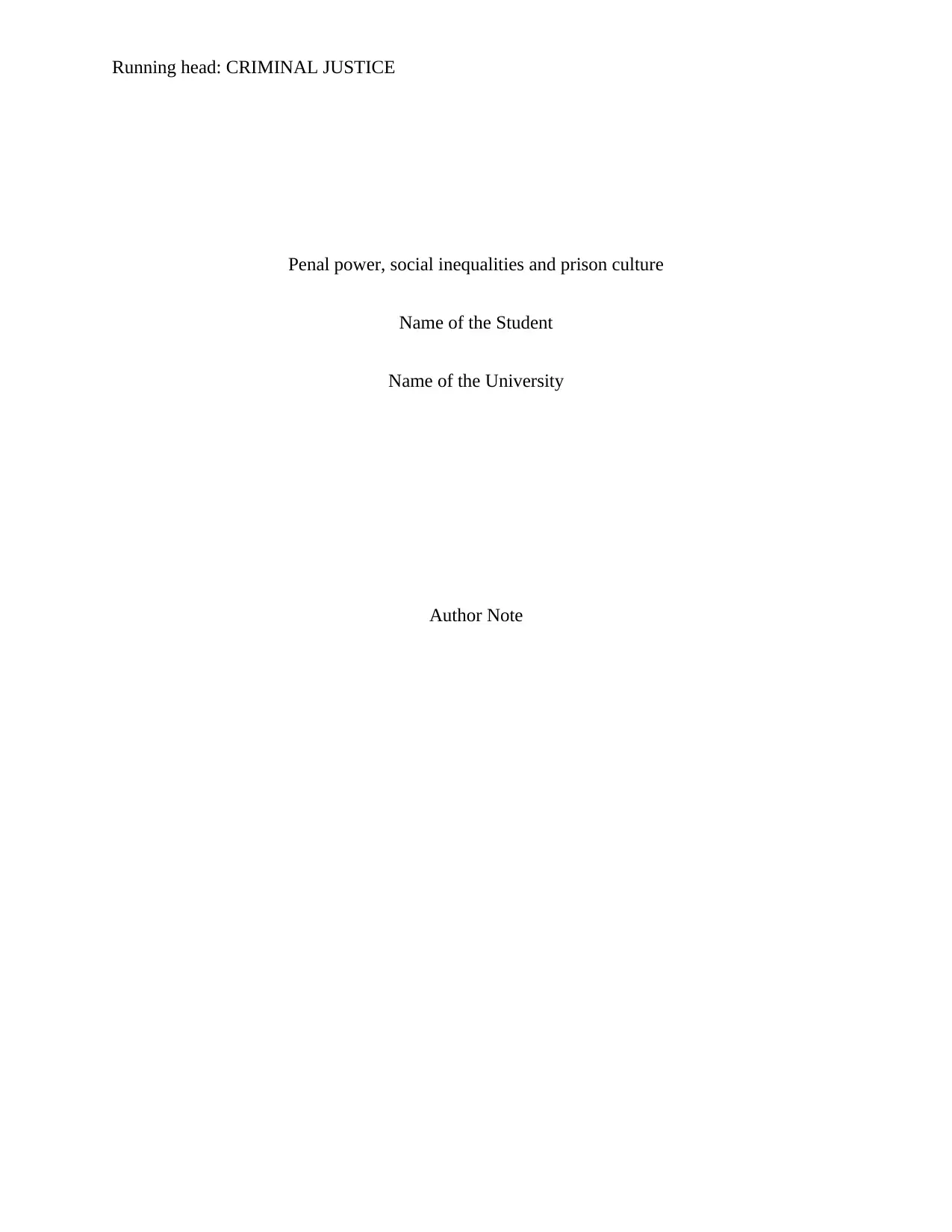
Running head: CRIMINAL JUSTICE
Penal power, social inequalities and prison culture
Name of the Student
Name of the University
Author Note
Penal power, social inequalities and prison culture
Name of the Student
Name of the University
Author Note
Secure Best Marks with AI Grader
Need help grading? Try our AI Grader for instant feedback on your assignments.
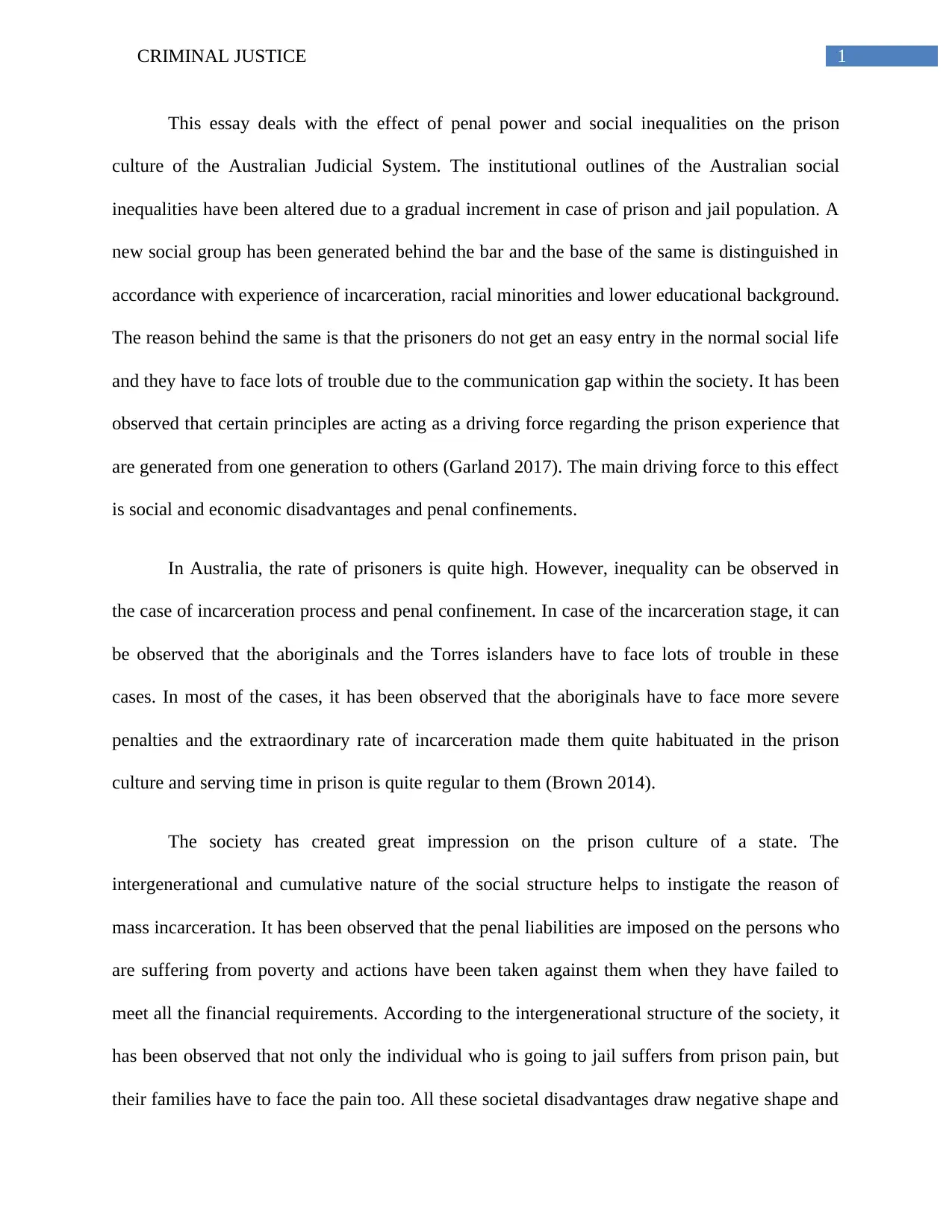
1CRIMINAL JUSTICE
This essay deals with the effect of penal power and social inequalities on the prison
culture of the Australian Judicial System. The institutional outlines of the Australian social
inequalities have been altered due to a gradual increment in case of prison and jail population. A
new social group has been generated behind the bar and the base of the same is distinguished in
accordance with experience of incarceration, racial minorities and lower educational background.
The reason behind the same is that the prisoners do not get an easy entry in the normal social life
and they have to face lots of trouble due to the communication gap within the society. It has been
observed that certain principles are acting as a driving force regarding the prison experience that
are generated from one generation to others (Garland 2017). The main driving force to this effect
is social and economic disadvantages and penal confinements.
In Australia, the rate of prisoners is quite high. However, inequality can be observed in
the case of incarceration process and penal confinement. In case of the incarceration stage, it can
be observed that the aboriginals and the Torres islanders have to face lots of trouble in these
cases. In most of the cases, it has been observed that the aboriginals have to face more severe
penalties and the extraordinary rate of incarceration made them quite habituated in the prison
culture and serving time in prison is quite regular to them (Brown 2014).
The society has created great impression on the prison culture of a state. The
intergenerational and cumulative nature of the social structure helps to instigate the reason of
mass incarceration. It has been observed that the penal liabilities are imposed on the persons who
are suffering from poverty and actions have been taken against them when they have failed to
meet all the financial requirements. According to the intergenerational structure of the society, it
has been observed that not only the individual who is going to jail suffers from prison pain, but
their families have to face the pain too. All these societal disadvantages draw negative shape and
This essay deals with the effect of penal power and social inequalities on the prison
culture of the Australian Judicial System. The institutional outlines of the Australian social
inequalities have been altered due to a gradual increment in case of prison and jail population. A
new social group has been generated behind the bar and the base of the same is distinguished in
accordance with experience of incarceration, racial minorities and lower educational background.
The reason behind the same is that the prisoners do not get an easy entry in the normal social life
and they have to face lots of trouble due to the communication gap within the society. It has been
observed that certain principles are acting as a driving force regarding the prison experience that
are generated from one generation to others (Garland 2017). The main driving force to this effect
is social and economic disadvantages and penal confinements.
In Australia, the rate of prisoners is quite high. However, inequality can be observed in
the case of incarceration process and penal confinement. In case of the incarceration stage, it can
be observed that the aboriginals and the Torres islanders have to face lots of trouble in these
cases. In most of the cases, it has been observed that the aboriginals have to face more severe
penalties and the extraordinary rate of incarceration made them quite habituated in the prison
culture and serving time in prison is quite regular to them (Brown 2014).
The society has created great impression on the prison culture of a state. The
intergenerational and cumulative nature of the social structure helps to instigate the reason of
mass incarceration. It has been observed that the penal liabilities are imposed on the persons who
are suffering from poverty and actions have been taken against them when they have failed to
meet all the financial requirements. According to the intergenerational structure of the society, it
has been observed that not only the individual who is going to jail suffers from prison pain, but
their families have to face the pain too. All these societal disadvantages draw negative shape and

2CRIMINAL JUSTICE
practices in the prison. In the continents of Western Australia, it has been observed that one in
every thirteen prisoners are from the aboriginal group and in the words of Gerry Georgatos
(2016), one in four aboriginal citizen of Australia has to experience prison life. The most
common thing regarding the aboriginal prisoners are that they are economically backward
classes and they are culturally disconnected from the modern world (Nafstad 2017). Considering
the rate of incarceration, the Western part of Australia is known as mother of all jailors.
According to Cunneen, the aboriginal Australian has to face certain discriminatory things that
forced them to commit suicide at a large level. Gosford has observed it that the aboriginal people
have to face serious problems due to lack of opportunities and social isolation provides them
negative prison experience to them.
The mentality of the Australians regarding the aboriginals is quite parochial in nature
and therefore, they have to face troubles behind the bar also. The rate of custodial death is quite
higher among the aboriginal tribes and it has been observed that the over-representation of
aboriginal people drive the criminal justice system in Australia (Crewe 2015).
National Aboriginal and Islander Legal Services Secretariat (NAILSS) reflect the original
atmosphere of the prison where the life of the aboriginals is filthy and they have no rights there
(aic.gov.au 2017). On the other hand, it has been observed in the contents of Australia that the
male prisoners overwhelm the prisons. Further, it has been observed that almost 90% of the
prisoners are from aboriginal background. All the local jails have same conditions and it has
been noticed that the penal process in case of the aboriginals are quite different compare to the
other people of Australia. In the modern time, the rates of female prisoners are increased a lot
and it has been observed that the incarceration rate of Australia has been gradually increased for
the same. Society plays an important role in these cases. The family members of the prisoners are
practices in the prison. In the continents of Western Australia, it has been observed that one in
every thirteen prisoners are from the aboriginal group and in the words of Gerry Georgatos
(2016), one in four aboriginal citizen of Australia has to experience prison life. The most
common thing regarding the aboriginal prisoners are that they are economically backward
classes and they are culturally disconnected from the modern world (Nafstad 2017). Considering
the rate of incarceration, the Western part of Australia is known as mother of all jailors.
According to Cunneen, the aboriginal Australian has to face certain discriminatory things that
forced them to commit suicide at a large level. Gosford has observed it that the aboriginal people
have to face serious problems due to lack of opportunities and social isolation provides them
negative prison experience to them.
The mentality of the Australians regarding the aboriginals is quite parochial in nature
and therefore, they have to face troubles behind the bar also. The rate of custodial death is quite
higher among the aboriginal tribes and it has been observed that the over-representation of
aboriginal people drive the criminal justice system in Australia (Crewe 2015).
National Aboriginal and Islander Legal Services Secretariat (NAILSS) reflect the original
atmosphere of the prison where the life of the aboriginals is filthy and they have no rights there
(aic.gov.au 2017). On the other hand, it has been observed in the contents of Australia that the
male prisoners overwhelm the prisons. Further, it has been observed that almost 90% of the
prisoners are from aboriginal background. All the local jails have same conditions and it has
been noticed that the penal process in case of the aboriginals are quite different compare to the
other people of Australia. In the modern time, the rates of female prisoners are increased a lot
and it has been observed that the incarceration rate of Australia has been gradually increased for
the same. Society plays an important role in these cases. The family members of the prisoners are
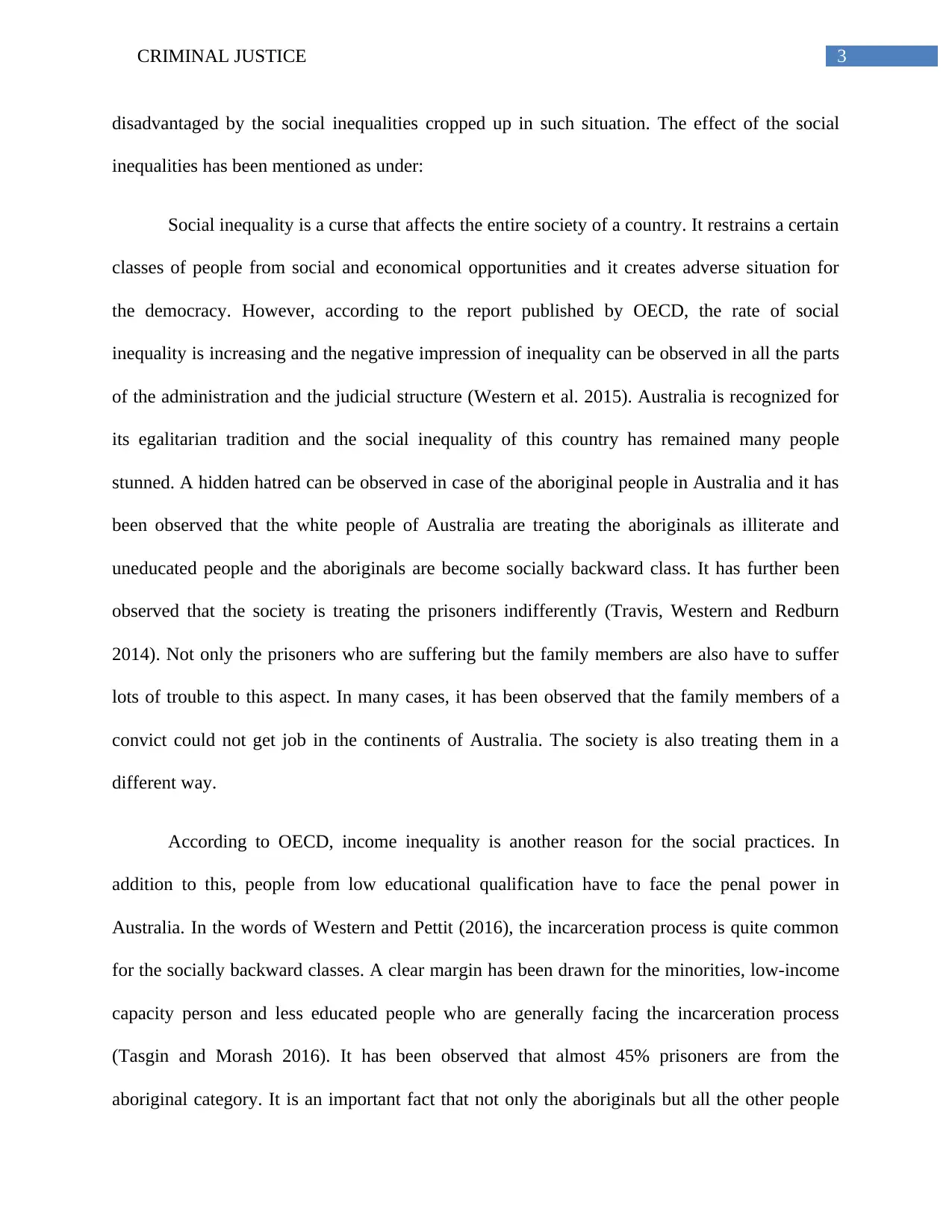
3CRIMINAL JUSTICE
disadvantaged by the social inequalities cropped up in such situation. The effect of the social
inequalities has been mentioned as under:
Social inequality is a curse that affects the entire society of a country. It restrains a certain
classes of people from social and economical opportunities and it creates adverse situation for
the democracy. However, according to the report published by OECD, the rate of social
inequality is increasing and the negative impression of inequality can be observed in all the parts
of the administration and the judicial structure (Western et al. 2015). Australia is recognized for
its egalitarian tradition and the social inequality of this country has remained many people
stunned. A hidden hatred can be observed in case of the aboriginal people in Australia and it has
been observed that the white people of Australia are treating the aboriginals as illiterate and
uneducated people and the aboriginals are become socially backward class. It has further been
observed that the society is treating the prisoners indifferently (Travis, Western and Redburn
2014). Not only the prisoners who are suffering but the family members are also have to suffer
lots of trouble to this aspect. In many cases, it has been observed that the family members of a
convict could not get job in the continents of Australia. The society is also treating them in a
different way.
According to OECD, income inequality is another reason for the social practices. In
addition to this, people from low educational qualification have to face the penal power in
Australia. In the words of Western and Pettit (2016), the incarceration process is quite common
for the socially backward classes. A clear margin has been drawn for the minorities, low-income
capacity person and less educated people who are generally facing the incarceration process
(Tasgin and Morash 2016). It has been observed that almost 45% prisoners are from the
aboriginal category. It is an important fact that not only the aboriginals but all the other people
disadvantaged by the social inequalities cropped up in such situation. The effect of the social
inequalities has been mentioned as under:
Social inequality is a curse that affects the entire society of a country. It restrains a certain
classes of people from social and economical opportunities and it creates adverse situation for
the democracy. However, according to the report published by OECD, the rate of social
inequality is increasing and the negative impression of inequality can be observed in all the parts
of the administration and the judicial structure (Western et al. 2015). Australia is recognized for
its egalitarian tradition and the social inequality of this country has remained many people
stunned. A hidden hatred can be observed in case of the aboriginal people in Australia and it has
been observed that the white people of Australia are treating the aboriginals as illiterate and
uneducated people and the aboriginals are become socially backward class. It has further been
observed that the society is treating the prisoners indifferently (Travis, Western and Redburn
2014). Not only the prisoners who are suffering but the family members are also have to suffer
lots of trouble to this aspect. In many cases, it has been observed that the family members of a
convict could not get job in the continents of Australia. The society is also treating them in a
different way.
According to OECD, income inequality is another reason for the social practices. In
addition to this, people from low educational qualification have to face the penal power in
Australia. In the words of Western and Pettit (2016), the incarceration process is quite common
for the socially backward classes. A clear margin has been drawn for the minorities, low-income
capacity person and less educated people who are generally facing the incarceration process
(Tasgin and Morash 2016). It has been observed that almost 45% prisoners are from the
aboriginal category. It is an important fact that not only the aboriginals but all the other people
Secure Best Marks with AI Grader
Need help grading? Try our AI Grader for instant feedback on your assignments.

4CRIMINAL JUSTICE
who are coming under the purview of these elements have to face the penal powers. These social
inequalities have forced the people of these category think that prison is a part of their life.
Western and Pettit have called this provision as invisible and cumulative. The hidden hatred of
the society against those prisoners and socially backwards classes is the main obstacle for their
normal social interaction. The prisoners could not become a part of the workforce, they are not
allowed to live their normal family life and they are restrained to work due to permanent blotting
in their resumes. All these have made the process of incarceration a threat to their existence. In
this report, the effect of penal powers and social inequalities on the prison life has been
engraved. The most important highlight regarding this topic is the issue of racial and class
disparity in case of the prison population. According to Western (2016), “Socioeconomic
disadvantage, crime, and incarceration in the current generation undermine the stability of family
life and material support for children. As adults, these children will be at greater risk of
diminished life chances and criminal involvement and at greater risk of incarceration as a result.
There were many examples that showed patterns of ethnicities and classes that were being
incarcerated more compare to others”.
A common pattern has been observed in the prisons of Australia regarding the prison
culture. it has been observed that a new society has been formed behind the bar who are sharing
their experience of poverty, racial minorities, low educational backgrounds and process of penal
power for their incarceration (Fan 2017). It is a common process that the prisoners are not
getting a fair chance for leading the common social lifestyles and restriction for job opportunities
make them economically disadvantage group.
The influence of penal power is also important for the shape practice and experience in
the prison. The rate of penal power can be observed in case of the lifestyle of formerly
who are coming under the purview of these elements have to face the penal powers. These social
inequalities have forced the people of these category think that prison is a part of their life.
Western and Pettit have called this provision as invisible and cumulative. The hidden hatred of
the society against those prisoners and socially backwards classes is the main obstacle for their
normal social interaction. The prisoners could not become a part of the workforce, they are not
allowed to live their normal family life and they are restrained to work due to permanent blotting
in their resumes. All these have made the process of incarceration a threat to their existence. In
this report, the effect of penal powers and social inequalities on the prison life has been
engraved. The most important highlight regarding this topic is the issue of racial and class
disparity in case of the prison population. According to Western (2016), “Socioeconomic
disadvantage, crime, and incarceration in the current generation undermine the stability of family
life and material support for children. As adults, these children will be at greater risk of
diminished life chances and criminal involvement and at greater risk of incarceration as a result.
There were many examples that showed patterns of ethnicities and classes that were being
incarcerated more compare to others”.
A common pattern has been observed in the prisons of Australia regarding the prison
culture. it has been observed that a new society has been formed behind the bar who are sharing
their experience of poverty, racial minorities, low educational backgrounds and process of penal
power for their incarceration (Fan 2017). It is a common process that the prisoners are not
getting a fair chance for leading the common social lifestyles and restriction for job opportunities
make them economically disadvantage group.
The influence of penal power is also important for the shape practice and experience in
the prison. The rate of penal power can be observed in case of the lifestyle of formerly
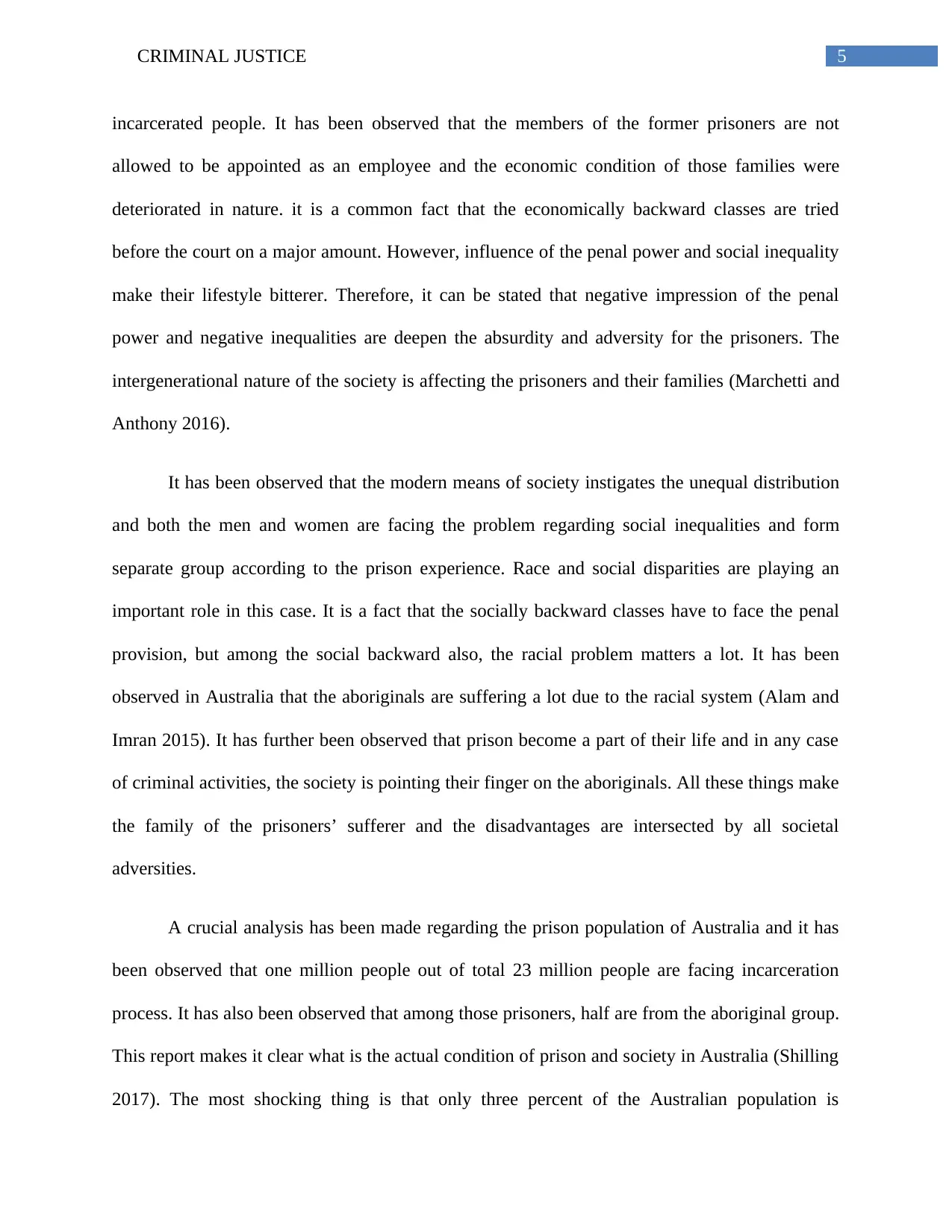
5CRIMINAL JUSTICE
incarcerated people. It has been observed that the members of the former prisoners are not
allowed to be appointed as an employee and the economic condition of those families were
deteriorated in nature. it is a common fact that the economically backward classes are tried
before the court on a major amount. However, influence of the penal power and social inequality
make their lifestyle bitterer. Therefore, it can be stated that negative impression of the penal
power and negative inequalities are deepen the absurdity and adversity for the prisoners. The
intergenerational nature of the society is affecting the prisoners and their families (Marchetti and
Anthony 2016).
It has been observed that the modern means of society instigates the unequal distribution
and both the men and women are facing the problem regarding social inequalities and form
separate group according to the prison experience. Race and social disparities are playing an
important role in this case. It is a fact that the socially backward classes have to face the penal
provision, but among the social backward also, the racial problem matters a lot. It has been
observed in Australia that the aboriginals are suffering a lot due to the racial system (Alam and
Imran 2015). It has further been observed that prison become a part of their life and in any case
of criminal activities, the society is pointing their finger on the aboriginals. All these things make
the family of the prisoners’ sufferer and the disadvantages are intersected by all societal
adversities.
A crucial analysis has been made regarding the prison population of Australia and it has
been observed that one million people out of total 23 million people are facing incarceration
process. It has also been observed that among those prisoners, half are from the aboriginal group.
This report makes it clear what is the actual condition of prison and society in Australia (Shilling
2017). The most shocking thing is that only three percent of the Australian population is
incarcerated people. It has been observed that the members of the former prisoners are not
allowed to be appointed as an employee and the economic condition of those families were
deteriorated in nature. it is a common fact that the economically backward classes are tried
before the court on a major amount. However, influence of the penal power and social inequality
make their lifestyle bitterer. Therefore, it can be stated that negative impression of the penal
power and negative inequalities are deepen the absurdity and adversity for the prisoners. The
intergenerational nature of the society is affecting the prisoners and their families (Marchetti and
Anthony 2016).
It has been observed that the modern means of society instigates the unequal distribution
and both the men and women are facing the problem regarding social inequalities and form
separate group according to the prison experience. Race and social disparities are playing an
important role in this case. It is a fact that the socially backward classes have to face the penal
provision, but among the social backward also, the racial problem matters a lot. It has been
observed in Australia that the aboriginals are suffering a lot due to the racial system (Alam and
Imran 2015). It has further been observed that prison become a part of their life and in any case
of criminal activities, the society is pointing their finger on the aboriginals. All these things make
the family of the prisoners’ sufferer and the disadvantages are intersected by all societal
adversities.
A crucial analysis has been made regarding the prison population of Australia and it has
been observed that one million people out of total 23 million people are facing incarceration
process. It has also been observed that among those prisoners, half are from the aboriginal group.
This report makes it clear what is the actual condition of prison and society in Australia (Shilling
2017). The most shocking thing is that only three percent of the Australian population is
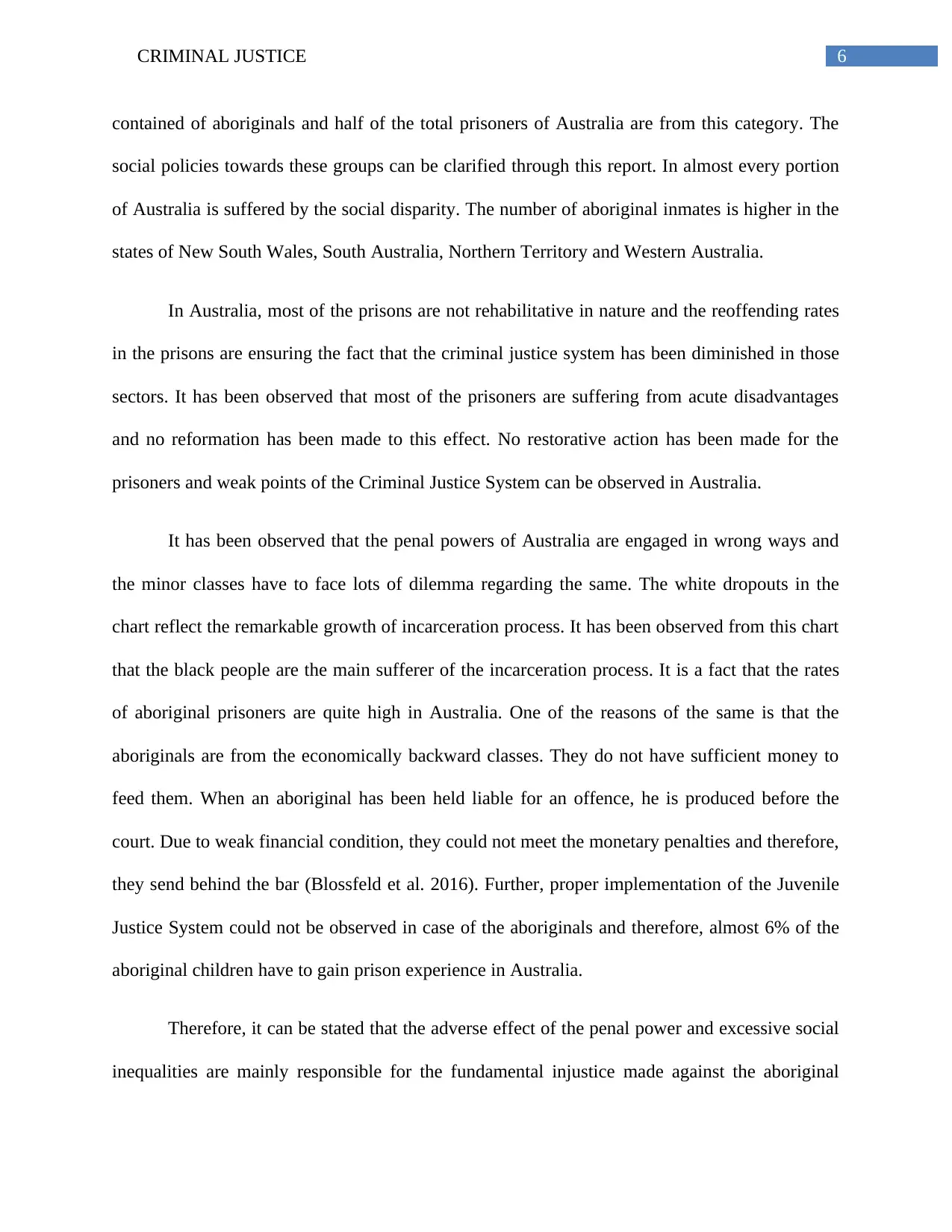
6CRIMINAL JUSTICE
contained of aboriginals and half of the total prisoners of Australia are from this category. The
social policies towards these groups can be clarified through this report. In almost every portion
of Australia is suffered by the social disparity. The number of aboriginal inmates is higher in the
states of New South Wales, South Australia, Northern Territory and Western Australia.
In Australia, most of the prisons are not rehabilitative in nature and the reoffending rates
in the prisons are ensuring the fact that the criminal justice system has been diminished in those
sectors. It has been observed that most of the prisoners are suffering from acute disadvantages
and no reformation has been made to this effect. No restorative action has been made for the
prisoners and weak points of the Criminal Justice System can be observed in Australia.
It has been observed that the penal powers of Australia are engaged in wrong ways and
the minor classes have to face lots of dilemma regarding the same. The white dropouts in the
chart reflect the remarkable growth of incarceration process. It has been observed from this chart
that the black people are the main sufferer of the incarceration process. It is a fact that the rates
of aboriginal prisoners are quite high in Australia. One of the reasons of the same is that the
aboriginals are from the economically backward classes. They do not have sufficient money to
feed them. When an aboriginal has been held liable for an offence, he is produced before the
court. Due to weak financial condition, they could not meet the monetary penalties and therefore,
they send behind the bar (Blossfeld et al. 2016). Further, proper implementation of the Juvenile
Justice System could not be observed in case of the aboriginals and therefore, almost 6% of the
aboriginal children have to gain prison experience in Australia.
Therefore, it can be stated that the adverse effect of the penal power and excessive social
inequalities are mainly responsible for the fundamental injustice made against the aboriginal
contained of aboriginals and half of the total prisoners of Australia are from this category. The
social policies towards these groups can be clarified through this report. In almost every portion
of Australia is suffered by the social disparity. The number of aboriginal inmates is higher in the
states of New South Wales, South Australia, Northern Territory and Western Australia.
In Australia, most of the prisons are not rehabilitative in nature and the reoffending rates
in the prisons are ensuring the fact that the criminal justice system has been diminished in those
sectors. It has been observed that most of the prisoners are suffering from acute disadvantages
and no reformation has been made to this effect. No restorative action has been made for the
prisoners and weak points of the Criminal Justice System can be observed in Australia.
It has been observed that the penal powers of Australia are engaged in wrong ways and
the minor classes have to face lots of dilemma regarding the same. The white dropouts in the
chart reflect the remarkable growth of incarceration process. It has been observed from this chart
that the black people are the main sufferer of the incarceration process. It is a fact that the rates
of aboriginal prisoners are quite high in Australia. One of the reasons of the same is that the
aboriginals are from the economically backward classes. They do not have sufficient money to
feed them. When an aboriginal has been held liable for an offence, he is produced before the
court. Due to weak financial condition, they could not meet the monetary penalties and therefore,
they send behind the bar (Blossfeld et al. 2016). Further, proper implementation of the Juvenile
Justice System could not be observed in case of the aboriginals and therefore, almost 6% of the
aboriginal children have to gain prison experience in Australia.
Therefore, it can be stated that the adverse effect of the penal power and excessive social
inequalities are mainly responsible for the fundamental injustice made against the aboriginal
Paraphrase This Document
Need a fresh take? Get an instant paraphrase of this document with our AI Paraphraser
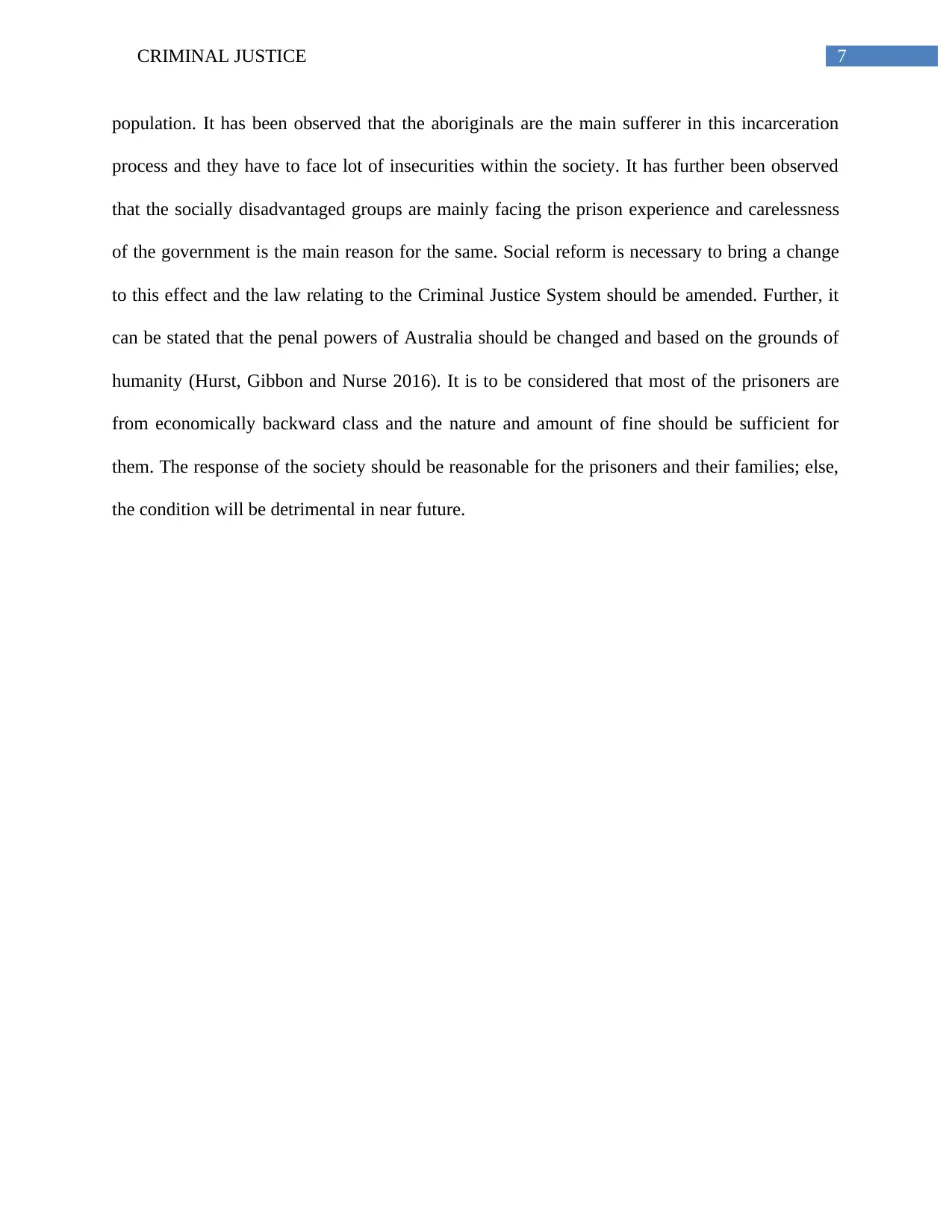
7CRIMINAL JUSTICE
population. It has been observed that the aboriginals are the main sufferer in this incarceration
process and they have to face lot of insecurities within the society. It has further been observed
that the socially disadvantaged groups are mainly facing the prison experience and carelessness
of the government is the main reason for the same. Social reform is necessary to bring a change
to this effect and the law relating to the Criminal Justice System should be amended. Further, it
can be stated that the penal powers of Australia should be changed and based on the grounds of
humanity (Hurst, Gibbon and Nurse 2016). It is to be considered that most of the prisoners are
from economically backward class and the nature and amount of fine should be sufficient for
them. The response of the society should be reasonable for the prisoners and their families; else,
the condition will be detrimental in near future.
population. It has been observed that the aboriginals are the main sufferer in this incarceration
process and they have to face lot of insecurities within the society. It has further been observed
that the socially disadvantaged groups are mainly facing the prison experience and carelessness
of the government is the main reason for the same. Social reform is necessary to bring a change
to this effect and the law relating to the Criminal Justice System should be amended. Further, it
can be stated that the penal powers of Australia should be changed and based on the grounds of
humanity (Hurst, Gibbon and Nurse 2016). It is to be considered that most of the prisoners are
from economically backward class and the nature and amount of fine should be sufficient for
them. The response of the society should be reasonable for the prisoners and their families; else,
the condition will be detrimental in near future.
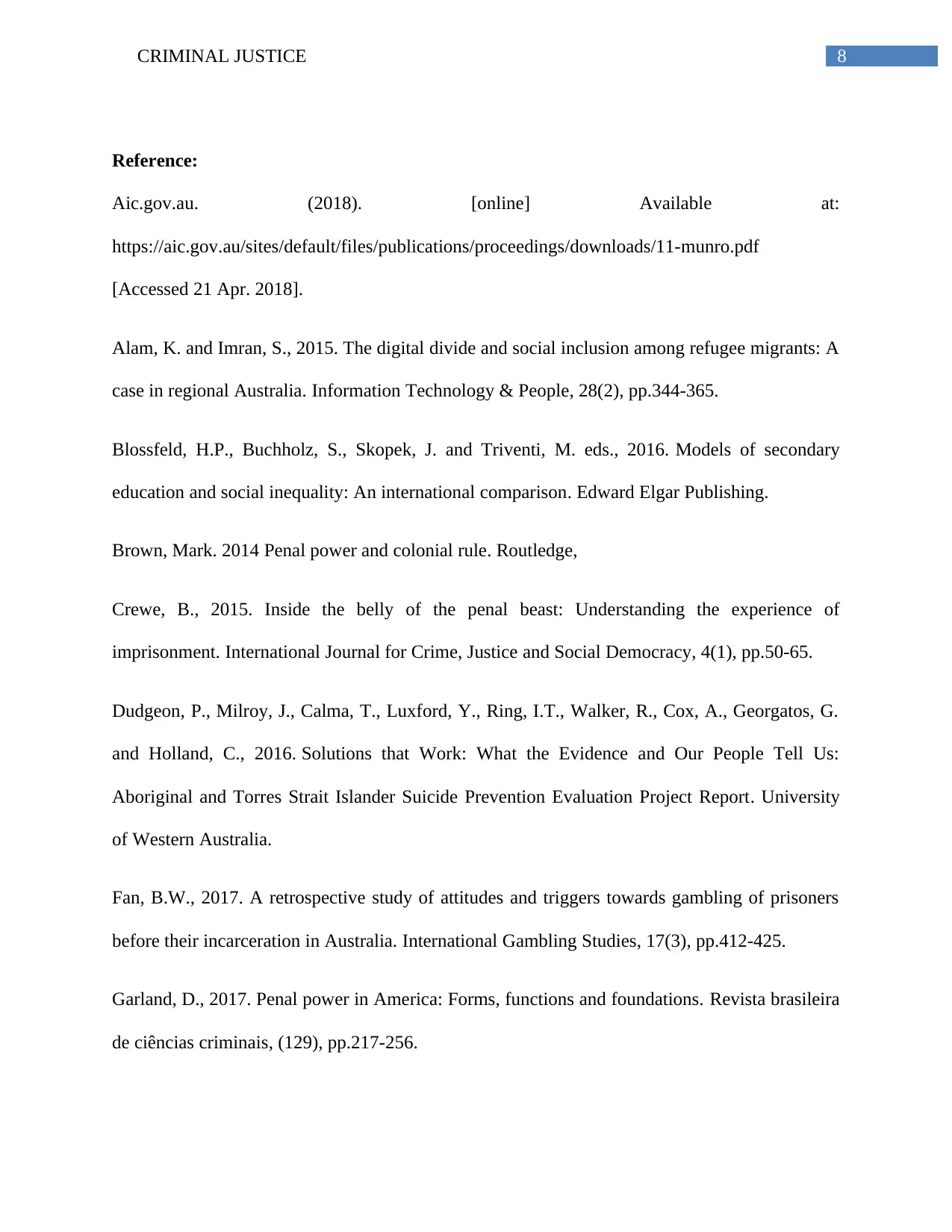
8CRIMINAL JUSTICE
Reference:
Aic.gov.au. (2018). [online] Available at:
https://aic.gov.au/sites/default/files/publications/proceedings/downloads/11-munro.pdf
[Accessed 21 Apr. 2018].
Alam, K. and Imran, S., 2015. The digital divide and social inclusion among refugee migrants: A
case in regional Australia. Information Technology & People, 28(2), pp.344-365.
Blossfeld, H.P., Buchholz, S., Skopek, J. and Triventi, M. eds., 2016. Models of secondary
education and social inequality: An international comparison. Edward Elgar Publishing.
Brown, Mark. 2014 Penal power and colonial rule. Routledge,
Crewe, B., 2015. Inside the belly of the penal beast: Understanding the experience of
imprisonment. International Journal for Crime, Justice and Social Democracy, 4(1), pp.50-65.
Dudgeon, P., Milroy, J., Calma, T., Luxford, Y., Ring, I.T., Walker, R., Cox, A., Georgatos, G.
and Holland, C., 2016. Solutions that Work: What the Evidence and Our People Tell Us:
Aboriginal and Torres Strait Islander Suicide Prevention Evaluation Project Report. University
of Western Australia.
Fan, B.W., 2017. A retrospective study of attitudes and triggers towards gambling of prisoners
before their incarceration in Australia. International Gambling Studies, 17(3), pp.412-425.
Garland, D., 2017. Penal power in America: Forms, functions and foundations. Revista brasileira
de ciências criminais, (129), pp.217-256.
Reference:
Aic.gov.au. (2018). [online] Available at:
https://aic.gov.au/sites/default/files/publications/proceedings/downloads/11-munro.pdf
[Accessed 21 Apr. 2018].
Alam, K. and Imran, S., 2015. The digital divide and social inclusion among refugee migrants: A
case in regional Australia. Information Technology & People, 28(2), pp.344-365.
Blossfeld, H.P., Buchholz, S., Skopek, J. and Triventi, M. eds., 2016. Models of secondary
education and social inequality: An international comparison. Edward Elgar Publishing.
Brown, Mark. 2014 Penal power and colonial rule. Routledge,
Crewe, B., 2015. Inside the belly of the penal beast: Understanding the experience of
imprisonment. International Journal for Crime, Justice and Social Democracy, 4(1), pp.50-65.
Dudgeon, P., Milroy, J., Calma, T., Luxford, Y., Ring, I.T., Walker, R., Cox, A., Georgatos, G.
and Holland, C., 2016. Solutions that Work: What the Evidence and Our People Tell Us:
Aboriginal and Torres Strait Islander Suicide Prevention Evaluation Project Report. University
of Western Australia.
Fan, B.W., 2017. A retrospective study of attitudes and triggers towards gambling of prisoners
before their incarceration in Australia. International Gambling Studies, 17(3), pp.412-425.
Garland, D., 2017. Penal power in America: Forms, functions and foundations. Revista brasileira
de ciências criminais, (129), pp.217-256.
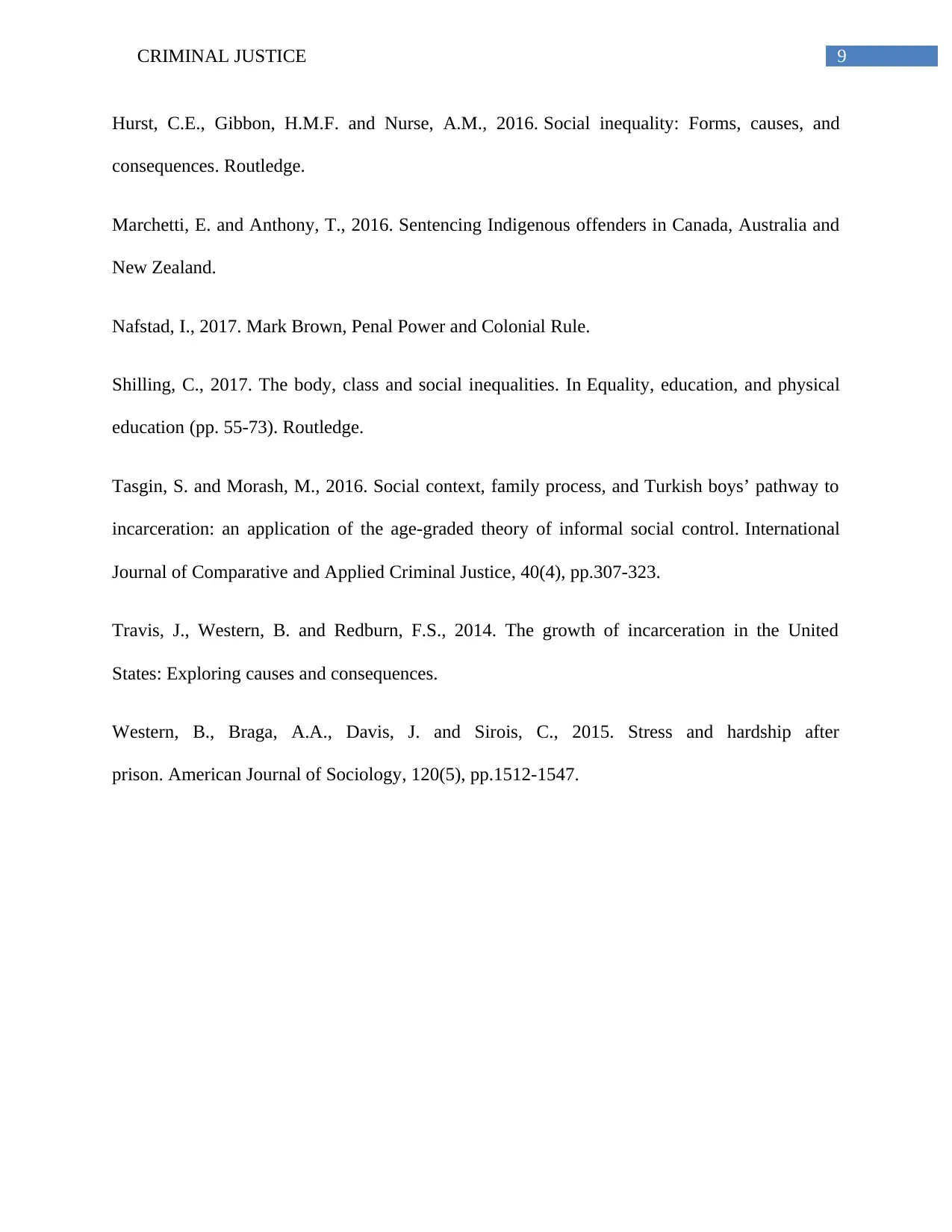
9CRIMINAL JUSTICE
Hurst, C.E., Gibbon, H.M.F. and Nurse, A.M., 2016. Social inequality: Forms, causes, and
consequences. Routledge.
Marchetti, E. and Anthony, T., 2016. Sentencing Indigenous offenders in Canada, Australia and
New Zealand.
Nafstad, I., 2017. Mark Brown, Penal Power and Colonial Rule.
Shilling, C., 2017. The body, class and social inequalities. In Equality, education, and physical
education (pp. 55-73). Routledge.
Tasgin, S. and Morash, M., 2016. Social context, family process, and Turkish boys’ pathway to
incarceration: an application of the age-graded theory of informal social control. International
Journal of Comparative and Applied Criminal Justice, 40(4), pp.307-323.
Travis, J., Western, B. and Redburn, F.S., 2014. The growth of incarceration in the United
States: Exploring causes and consequences.
Western, B., Braga, A.A., Davis, J. and Sirois, C., 2015. Stress and hardship after
prison. American Journal of Sociology, 120(5), pp.1512-1547.
Hurst, C.E., Gibbon, H.M.F. and Nurse, A.M., 2016. Social inequality: Forms, causes, and
consequences. Routledge.
Marchetti, E. and Anthony, T., 2016. Sentencing Indigenous offenders in Canada, Australia and
New Zealand.
Nafstad, I., 2017. Mark Brown, Penal Power and Colonial Rule.
Shilling, C., 2017. The body, class and social inequalities. In Equality, education, and physical
education (pp. 55-73). Routledge.
Tasgin, S. and Morash, M., 2016. Social context, family process, and Turkish boys’ pathway to
incarceration: an application of the age-graded theory of informal social control. International
Journal of Comparative and Applied Criminal Justice, 40(4), pp.307-323.
Travis, J., Western, B. and Redburn, F.S., 2014. The growth of incarceration in the United
States: Exploring causes and consequences.
Western, B., Braga, A.A., Davis, J. and Sirois, C., 2015. Stress and hardship after
prison. American Journal of Sociology, 120(5), pp.1512-1547.
Secure Best Marks with AI Grader
Need help grading? Try our AI Grader for instant feedback on your assignments.
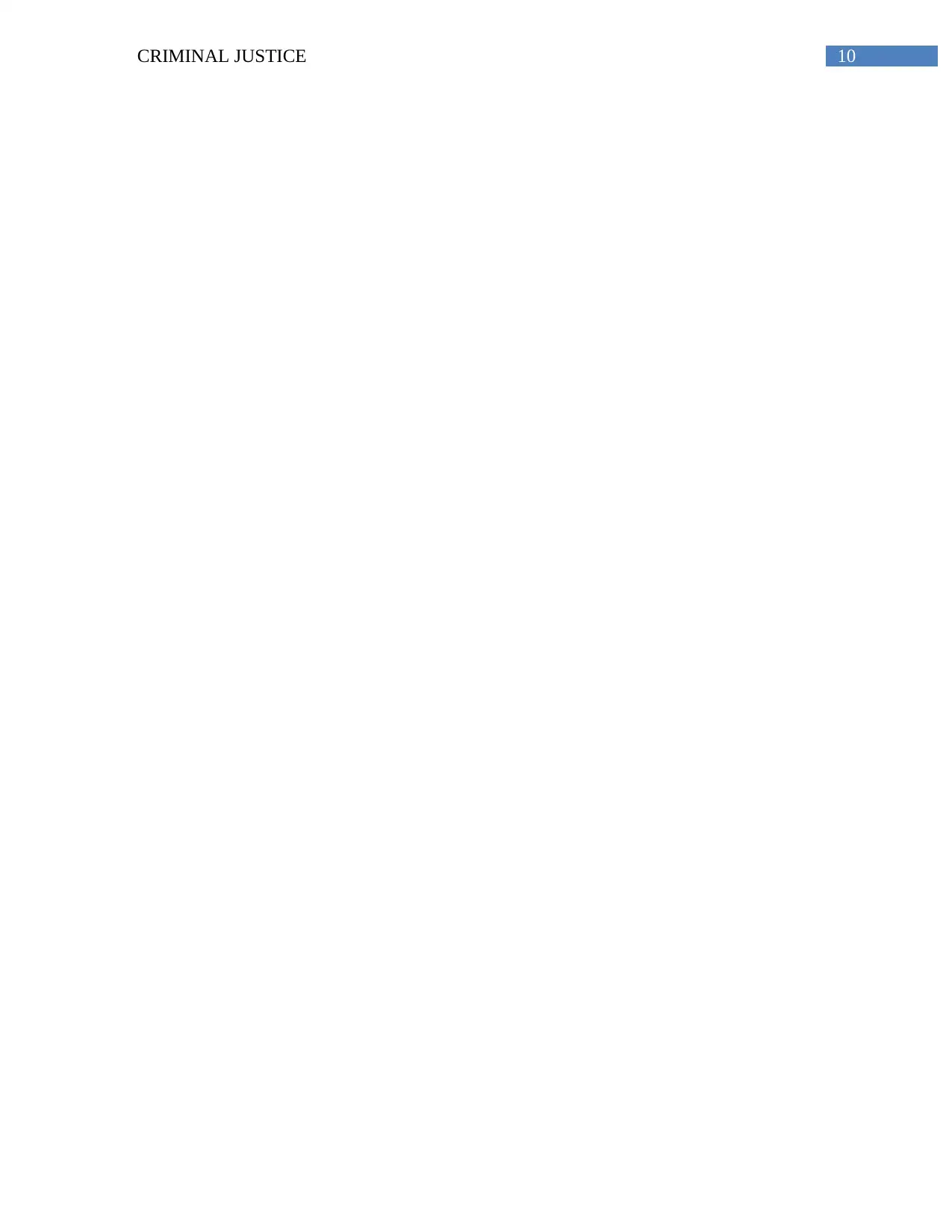
10CRIMINAL JUSTICE
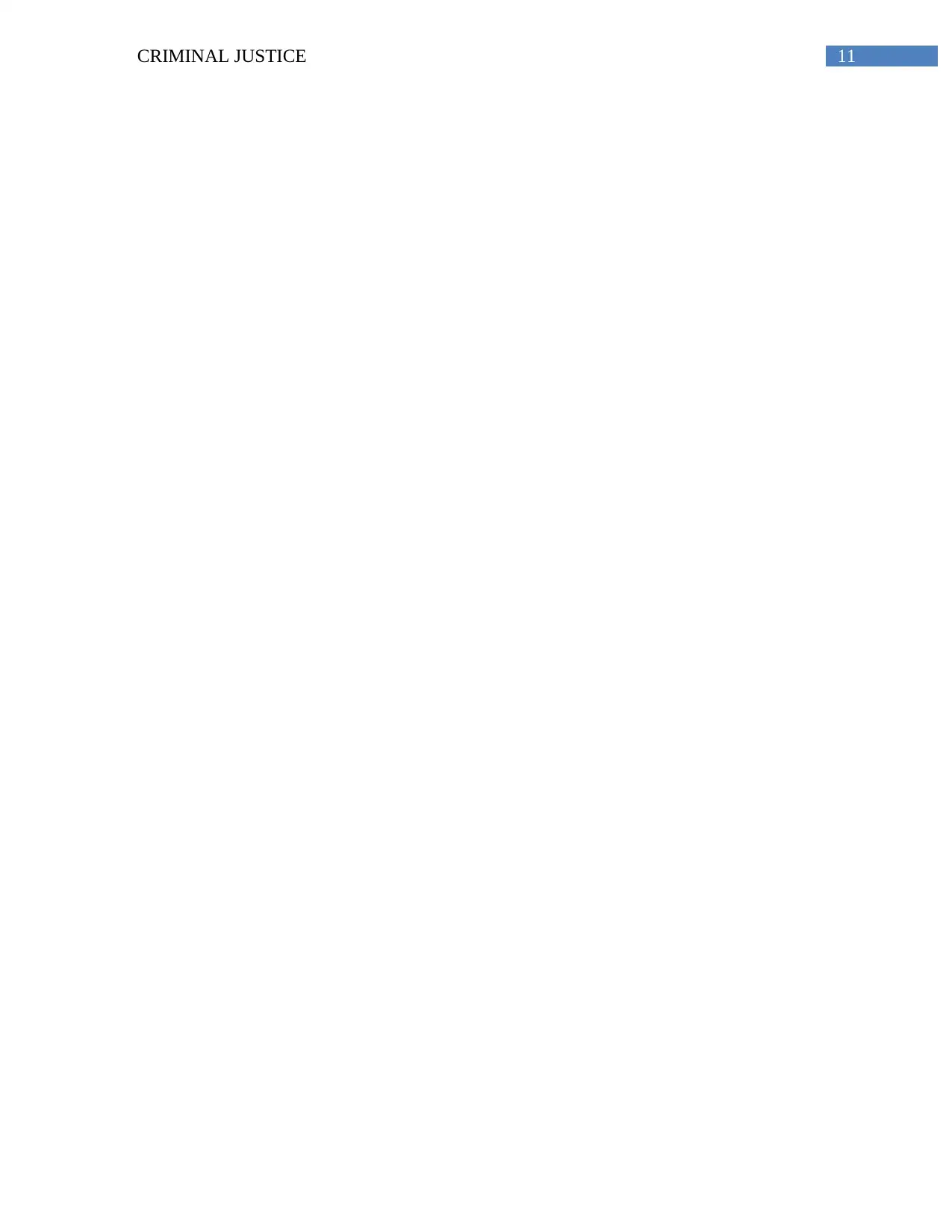
11CRIMINAL JUSTICE
1 out of 12
Related Documents
Your All-in-One AI-Powered Toolkit for Academic Success.
+13062052269
info@desklib.com
Available 24*7 on WhatsApp / Email
![[object Object]](/_next/static/media/star-bottom.7253800d.svg)
Unlock your academic potential
© 2024 | Zucol Services PVT LTD | All rights reserved.





